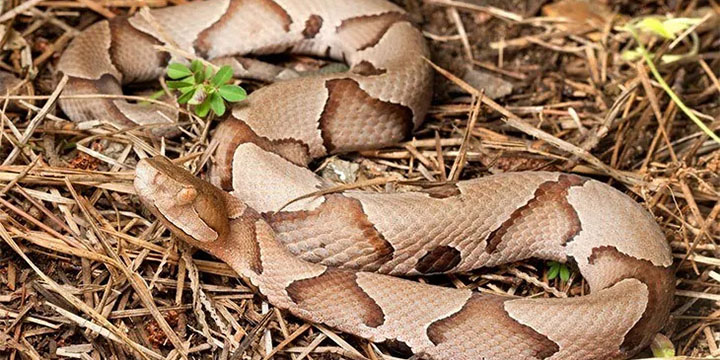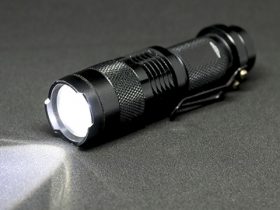Once there was a little boy named Bobby.
Bobby came home one summer day after playing in a nearby forested area near a stream by the new house. He came into the kitchen while his mother was making dinner. He smiled at his mother. And he said that he had caught some baby snakes. Could he keep them as pets?
Sure enough, he had 6 baby snakes in his hands and they looked cute and playful.
Bobby said he had found them lined up in a row down by the path along with the stream warming themselves in the sun.
They had yellow tails, copper-colored wedge-shaped heads, and their eyes looked like those of a cat. They were only about 12 inches long or about the size of a garter snake, though they looked chubbier than the slender build of the mouse and bug-eating backyard denizens.
Mom took one look at what her son was holding and she very calmly walked to the phone and dialed 911. Her son was holding 6 baby copperheads. Animal control arrived promptly and was able to coax the snakes into a bag without either the officer or the boy being bitten.
Needless to say, the boy got a crash course on what not to bring home and not to go into the woods unaccompanied again.
But, what would you do if you suddenly came face to face with a copperhead? Would you even know it was a dangerous snake?
How To Keep You Safe When Met A Copperhead Snake
Well, today you’ll be getting a crash course in how to identify the copperhead as it is one of the common venomous snake in North America, which can be found almost anywhere in the country as far south as Florida or even within 30 miles of Chicago or as far north just outside of Boston.
Learning how to ID them can protect you or a loved one from a potentially fatal encounter when walking or hiking in the woods or even in the suburbs near your home.
How To Identify A Copperhead Snake
How Do You Know You Are Looking At A Copperhead?
When you are attempting to identify a copperhead the first thing you need to know they are almost invisible to the naked eye. So when you are in the woods when leaves are on the ground you need to be careful where you put your feet as they are designed by nature to blend in with fallen leaves.
They are an ambush snake and so they can remain motionless until they strike. So, the first rule is not to put your feet down without looking where you step.
If you see, a snake, look at the shape of the head, the copperhead is a pit viper and their head has a characteristic shape.
If you look at it from the top, it is wedge-shaped and resembles the ace of spades or heart-shaped. Look last eyes and if the pupil looks like that of a cat this is the final confirmation you need to give this snake a wide breadth.
What’s Dangerous?
This is a dead giveaway for copperheads in North America. They hunt by thermal radiation and they pick up heat radiation of their prey through two pits located on either side of the snout. This distinguishing feature gives them the name of pit vipers.
The coloration is a copper brown that crosses over and down behind the eyes on the top of the head.
The underside of the head is a different shade and gives the head a two-tone appearance. The body is a mottled brown color in hourglass-shaped bands that have a darker border and the snake resembles the brown leaves it hides in awaiting its prey.
So, keeping on a wide path, stay alert, and stay away from brush piles will help you to avoid being bitten.
When approached, the copperhead will coil up into a ball. It will hold its head held above a chunky body. This is its strike position. From this pose, it can strike you at a distance of half the snake’s total length. So, your best bet when you see a snake in this position to leave it alone.
It can strike so fast your eye cannot catch the movement. The snake grows to be up to 3 feet in length and can strike to almost half that length. The jaw will open and its two needle-sharp fangs will leave twin punctures and you should seek medical attention immediately.
The good news is that the bite is only fatal in a minority of cases. Out of the 6-8,000 snakebites recorded each year, only a small fraction are by copperheads.
Snake anti-venom is kept on hand for such emergencies in hospitals where these snakes are to live. However, treatment can run you between 6 and 60,000 dollars. Therefore, prevention is preferable to treatment.
The Problem With Identifying This Snake Is That Other Snakes Resemble The Copperhead Too
Other snakes that you will find out in the same area look like the copperhead. The corn snake, the hog-nosed snake, and the milk snake all superficially look like a copperhead but you can tell the difference by the shape of the head, lack of pits, and the coloration of the head. The patterning is not hourglass-shaped bands. The pupils of their eyes are round instead of slit-shaped.
However, when in doubt err on the side of caution. Even a garter snake can give you a nasty bite if provoked.
Baby Copperheads Are Poisonous As Well
They resemble the parent in many respects except their tail is yellow and looks like a worm, which the baby snake uses as a lure to bring prey into range. They don’t inject as much venom into the punctures but the wound can be infected and is very painful.
What Do You Do If You Are Bitten?
As mentioned earlier seek help immediately, under no circumstances attempt to kill or capture the snake as it is likely you will be bitten again.
Above all else, remain calm and get to medical care.
Snakes Are And Have Been On Earth For Millions Of Years
They hunt and kill vermin and even the poisonous ones help us by keeping mice and rat numbers down. If you leave them, alone they will do the same in return. It is only when you get off the beaten path and are not aware of your surrounding do things go south.
Final Thoughts
Today, you’ve learned about the copperhead and though their venom is much less dangerous than the rattlesnake or the coral snake you still need to be careful around them and they are now getting closer to habited areas as houses are springing up on land that was theirs alone.
So forewarned is forearmed and you can now know if that snake you are looking at is a copperhead or one of its harmless cousins.
However, leave any snake in peace and it will do the same for you. In that, way you will avoid a painful bite and an expensive trip to the emergency room.







Leave a Reply